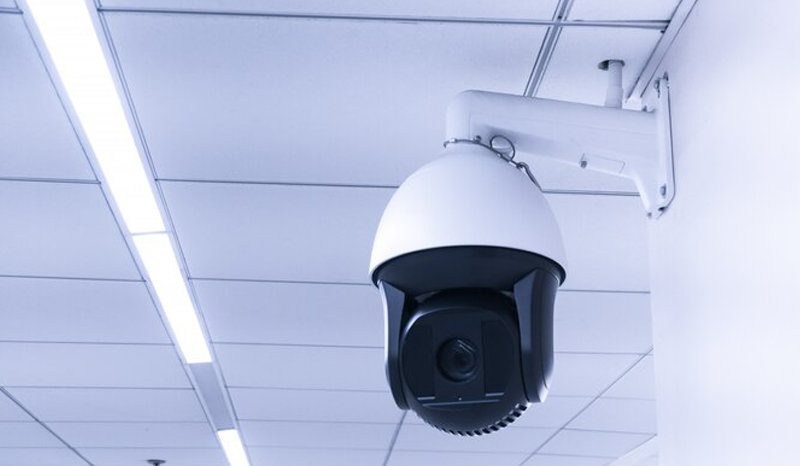- +971 52 814 2054
Free Consultation
Please fill this form.
PTZ Camera Abu Dhabi

PTZ CCTV Camera Abu Dhabi
Admin Jan 11,2023
What are PTZ and ePTZ Cameras?
Pan-tilt-zoom (PTZ) cameras are built with mechanical components that allow them to swivel left to right, tilt up and down, and zoom in and out of a scene. They’re generally used to monitor wide open areas requiring a 180- or 360-degree view, and deployed in guard stations wherever active personnel will operate them through a remote camera controller. Betting on the camera or software, they will also be set to follow motion-triggered activity or adhere to a pre-set schedule automatically. PTZ cameras are usually implemented in tandem with a bigger surveillance system, during which the PTZ tracks movement while a fixed camera takes elaborate shots.
While “PTZ” indicates a specific kind of camera hardware, “ePTZ” references a software feature. Electronic pan-tilt-zoom (ePTZ) security cameras don't physically move, however, use digital zoom to provide the pan-tilt-zoom effect on a fixed camera. This enables camera operators to enlarge areas they would prefer to concentrate on and prevents the gaps in coverage characteristic of traditional PTZ cameras. With some solutions providing 360° coverage, an ePTZ camera is a powerful way to give a PTZ-like experience whereas still recording the complete.
Features and Advantages of PTZ Cameras:
- Large Field of View:
PTZ cameras are wont to monitor a large space, and are sometimes suggested to use in conjunction with a fixed camera to avoid gaps in coverage. Depending on the model, cameras will move any place between zero pan/tilt and also the full 360-degree pan/180-degree tilt. Some solutions even have digital pan and tilt, that permit the video to be adjusted once recorded - although the resulting video would be grainier and lower res.
- Motion-Based auto Tracking:
Auto tracking could be a function that allows PTZ cameras to regulate their field of read to follow moving objects automatically. The use case for this function is often best applied in quiet areas with the least movement (for example, a museum once closing).
- Time-Based auto Scan:
PTZ cameras will be configured with auto-pilot to scan pre-defined areas and move-in patterns (tours). Preset positions will be programmed to change positions based on time. For example, a PTZ camera will be designed to pan, tilt, or zoom every 30 seconds to capture completely different areas of interest inside the camera’s overall surveillance area.
- Remote Camera Control:
Typical PTZ cameras will be manually and remotely adjusted to track suspicious activity. This enables users to change the camera’s field of reading while not having to go onsite.
- Zoom Capabilities:
Most PTZ cameras support optical zoom, which is used to look at and capture faraway objects like license plates or faces
Bullet Camera Cons
Though very useful in deterring thieves, bullet cameras conjointly come with cons. Cons to be cautious of include a number of the following:
- They are not as sturdy and can be more simply vandalised than dome cameras.
- Not very discreet.
- Their shape and outside nature will cause small birds to build nests around these devices.
Where PTZ cameras are commonly used:
The placement of the camera is crucial to eliminating blind spots, which could be a common issue with the PTZ.
- Guard stations
- Supermarkets
- Airports
- Churches
- Museums
- Construction Sites
- Large outdoor areas
Types of PTZ Cameras:
- PTZ IP Camera:
PTZ net protocol (IP) cameras will be deployed via WiFi or Power over LAN (PoE). Compared to old analog PTZ cameras wifi PTZ Camera: wifi PTZ cameras connect wirelessly to a router while not a hardwired affiliation. (However, they still need a power supply.) a powerful wifi connection is recommended to stop lag and video quality problems.
- PTZ Poe Camera:
A Poe camera uses a coax cable that plugs into a Poe switch to receive power and an online connection. It usually contains a connection distance way more potent than WiFi.
- PTZ Analog Camera:
PTZ Analog Camera: Analog (CCTV) PTZ cameras use an analog video signal to capture surveillance footage, and are wired to digital video recorders (DVRs) via concentric cables. Analog PTZ security cameras generally cannot transmit video information on their own and need a DVR to support converting, compressing, and saving footage.
- Outdoor PTZ Camera:
PTZ cameras that are deployed outdoors should be able to withstand a lot of extreme temperatures and atmospheric conditions. They’re generally encased {in a|during a|in an exceedingly|in a very} weatherproof exterior with an IP rating that indicates adequate protection against natural components.
- Wireless PTZ Camera:
In cases wherever the installer is unable to run video cables, wireless PTZ cameras can transmit video wirelessly. Generally, this is done through WiFi, though transmitter sets will be used to convert analog signals. Wireless PTZ cameras are generally deployed for long-distance outdoor monitoring wherever it’s tough or costly to run the cabling.
MCC Approved Company
Looking for Certified Trainer ?
We are ADMCC Approved company (Abu Dhabi Monitoring and Control Center). We Provide the best solution to you especially under success of MCC and for the prospective change.
Get AppointmentService We Provide
We are experts in CCTV Installation in UAE, Get the most affordable & secureCCTV solutions, IT Data Cabling, Network Cabling, Telephone Cabling, CCTV cabling Services.

Biometric System
Our Biometric Access Control system supports advanced live finger detection and face detection.
Read More
GPS Vehicle Tracking
The Most Modern GPS Based Vehicle Tracking Systems, Fleet Management, Vehicle Monitors.
Read More
Gate Barrier System
We make best Gate Barrier and Automatic Sliding / Entrance Gates Smooth, Easy & Noise Free.
Read More


















